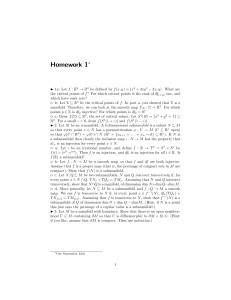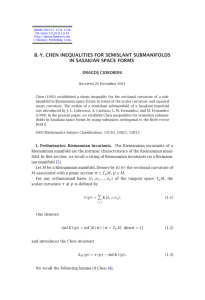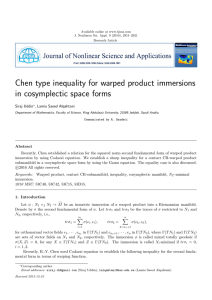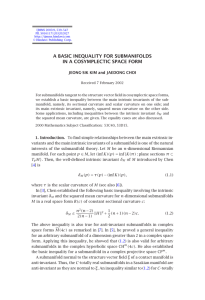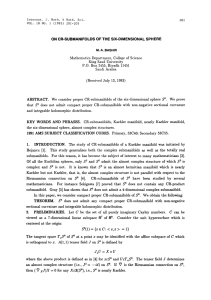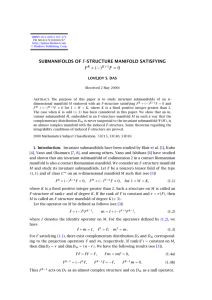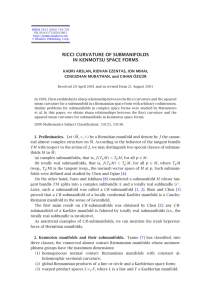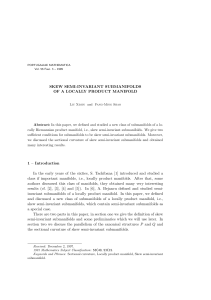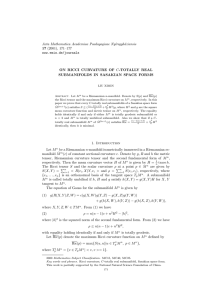A NOTE ON CHEN’S BASIC EQUALITY FOR SUBMANIFOLDS
advertisement
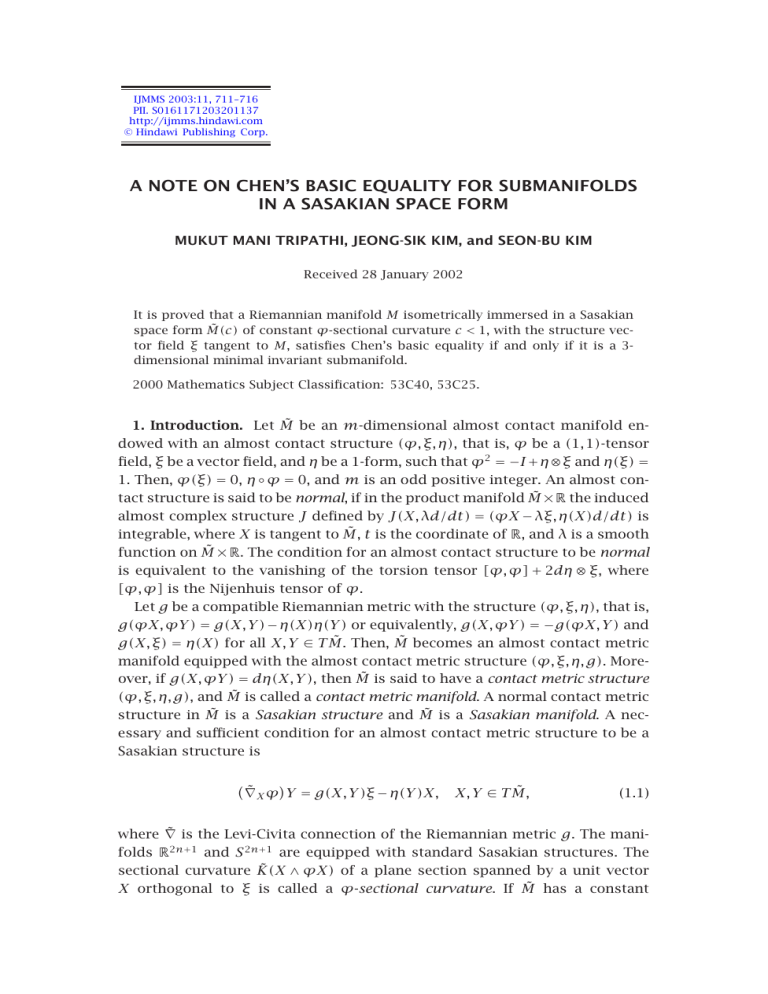
IJMMS 2003:11, 711–716
PII. S0161171203201137
http://ijmms.hindawi.com
© Hindawi Publishing Corp.
A NOTE ON CHEN’S BASIC EQUALITY FOR SUBMANIFOLDS
IN A SASAKIAN SPACE FORM
MUKUT MANI TRIPATHI, JEONG-SIK KIM, and SEON-BU KIM
Received 28 January 2002
It is proved that a Riemannian manifold M isometrically immersed in a Sasakian
space form M̃(c) of constant ϕ-sectional curvature c < 1, with the structure vector field ξ tangent to M, satisfies Chen’s basic equality if and only if it is a 3dimensional minimal invariant submanifold.
2000 Mathematics Subject Classification: 53C40, 53C25.
1. Introduction. Let M̃ be an m-dimensional almost contact manifold endowed with an almost contact structure (ϕ, ξ, η), that is, ϕ be a (1, 1)-tensor
field, ξ be a vector field, and η be a 1-form, such that ϕ2 = −I +η⊗ξ and η(ξ) =
1. Then, ϕ(ξ) = 0, η ◦ ϕ = 0, and m is an odd positive integer. An almost contact structure is said to be normal, if in the product manifold M̃ ×R the induced
almost complex structure J defined by J(X, λd/dt) = (ϕX − λξ, η(X)d/dt) is
integrable, where X is tangent to M̃, t is the coordinate of R, and λ is a smooth
function on M̃ ×R. The condition for an almost contact structure to be normal
is equivalent to the vanishing of the torsion tensor [ϕ, ϕ] + 2dη ⊗ ξ, where
[ϕ, ϕ] is the Nijenhuis tensor of ϕ.
Let g be a compatible Riemannian metric with the structure (ϕ, ξ, η), that is,
g(ϕX, ϕY ) = g(X, Y )−η(X)η(Y ) or equivalently, g(X, ϕY ) = −g(ϕX, Y ) and
g(X, ξ) = η(X) for all X, Y ∈ T M̃. Then, M̃ becomes an almost contact metric
manifold equipped with the almost contact metric structure (ϕ, ξ, η, g). Moreover, if g(X, ϕY ) = dη(X, Y ), then M̃ is said to have a contact metric structure
(ϕ, ξ, η, g), and M̃ is called a contact metric manifold. A normal contact metric
structure in M̃ is a Sasakian structure and M̃ is a Sasakian manifold. A necessary and sufficient condition for an almost contact metric structure to be a
Sasakian structure is
˜ X ϕ Y = g(X, Y )ξ − η(Y )X,
∇
X, Y ∈ T M̃,
(1.1)
˜ is the Levi-Civita connection of the Riemannian metric g. The maniwhere ∇
folds R2n+1 and S 2n+1 are equipped with standard Sasakian structures. The
sectional curvature K̃(X ∧ ϕX) of a plane section spanned by a unit vector
X orthogonal to ξ is called a ϕ-sectional curvature. If M̃ has a constant
712
MUKUT MANI TRIPATHI ET AL.
ϕ-sectional curvature c, then it is called a Sasakian space form and is denoted
by M̃(c). For more details, we refer to [2].
Let M be an n-dimensional submanifold immersed in an almost contact
metric manifold M̃(ϕ, ξ, η, g). Also let g denote the induced metric on M. We
denote by h the second fundamental form of M and by AN the shape operator
associated to any vector N in the normal bundle T ⊥ M. Then g(h(X, Y ), N) =
g(AN X, Y ) for all X, Y ∈ T M and N ∈ T ⊥ M. The mean curvature vector is given
by nH = trace(h), and the submanifold M is minimal if H = 0.
For a vector field X in M, we put ϕX = P X + F X, where P X ∈ T M and F X ∈
T ⊥ M. Thus, P is an endomorphism of the tangent bundle of M and satisfies
g(X, P Y ) = −g(P X, Y ) for all X, Y ∈ T M. From now on, let the structure vector
field ξ be tangent to M. Then we write the orthogonal direct decomposition
T M = Ᏸ ⊕ {ξ}. Let {e1 , . . . , en } be an orthonormal basis of the tangent space
n
Tp M. We can define the squared norm of P by P 2 = i,j=1 g(ei , P ej )2 . For
a plane section π ⊂ Tp M, we denote the functions α(π ) and β(π ) of tangent
space Tp M into [0, 1] by α(π ) = (g(X, P Y ))2 and β(π ) = (η(X))2 + (η(Y ))2 ,
where π is spanned by any orthonormal vectors X and Y .
The scalar curvature τ at p ∈ M is given by τ = i<j K(ei ∧ej ), where K(ei ∧
ej ) is the sectional curvature of the plane section spanned by ei and ej . The
well-known Chen’s invariant δM on M is defined by
δM = τ − inf K,
(1.2)
where (inf K)(p) = inf{K(π ) | π is a plane section ⊂ Tp M}. For a submanifold
M in a real space form Rm (c), Chen [4] gave the following inequality:
δM ≤
n2 (n − 2)
1
H2 + (n + 1)(n − 2)c.
2(n − 1)
2
(1.3)
He also established in [5] the similar basic inequalities for submanifolds in
a complex space form. For an n-dimensional submanifold M in a Sasakian
space form M̃(c) tangential to the structure vector field ξ in [7], the authors
established the following Chen’s basic inequality.
Theorem 1.1. Let M be an n-dimensional (n ≥ 3) Riemannian manifold
isometrically immersed in a Sasakian space form M̃(c) of constant ϕ-sectional
curvature c < 1 with the structure vector field ξ tangent to M. Then,
δM ≤
n2 (n − 2)
1
H2 +
n(n − 3)c + 3n2 − n − 8
2(n − 1)
8
(1.4)
with equality holding if and only if M admits a quasi-anti-invariant structure of
rank (n − 2).
A NOTE ON CHEN’S BASIC EQUALITY FOR SUBMANIFOLDS . . .
713
For certain inequalities concerned with the invariant δ(n1 , . . . , nk ), which is
a generalization of δM , we also refer to [6].
In this note, we prove the following obstruction to the Chen’s basic equality.
Theorem 1.2. Let M be an n-dimensional Riemannian manifold isometrically immersed in an m-dimensional Sasakian space form M̃(c) of a constant
ϕ-sectional curvature c < 1 with the structure vector field ξ tangent to M. Then,
M satisfies the Chen’s basic equality
δM =
n2 (n − 2)
1
H2 +
n(n − 3)c + 3n2 − n − 8 ,
2(n − 1)
8
(1.5)
if and only if M is a 3-dimensional minimal invariant submanifold. Hence,
Chen’s basic equality (1.5) becomes
δM = 2.
(1.6)
2. Proof of Theorem 1.2. First, we recall the following theorem [3].
Theorem 2.1. Let M̃ be an m-dimensional Sasakian space form M̃(c). Let
M be an n-dimensional (n ≥ 3) submanifold isometrically immersed in M̃ such
that ξ ∈ T M. For each plane section π ⊂ Ᏸp , p ∈ M,
τ − K(π ) ≤
1
n2 (n − 2)
H2 +
n(n − 3)c + 3n2 − n − 8
2(n − 1)
8
c −1
+
3P 2 − 6α(π ) .
8
(2.1)
The equality in (2.1) holds at p ∈ M if and only if there exist an orthonormal
basis {e1 , . . . , en } of Tp M and an orthonormal basis {en+1 , . . . , em } of Tp⊥ M such
that (a) en = ξ, (b) π = Span{e1 , e2 }, and (c) the shape operators Ar ≡ Aer ,
r = n + 1, . . . , m, take the following forms:
n+1
h11
0
An+1 =
0
.
.
.
0
r
h11
r
h12
Ar =
0
.
.
.
0
0
0
···
−hn+1
11
0
···
0
..
.
0
..
.
···
..
.
0
0
···
hr12
0
···
−hr11
0
···
0
..
.
0
..
.
···
..
.
0
0
···
0
0
0
0
,
..
.
0
(2.2)
0
0
,
..
.
0
r = n + 2, . . . , m.
714
MUKUT MANI TRIPATHI ET AL.
A submanifold M of an almost contact metric manifold M̃ with ξ ∈ T M is
called a semi-invariant submanifold [1] of M̃ if the distributions Ᏸ1 = T M ∩
ϕ(T M) and Ᏸ0 = T M ∩ϕ(T ⊥ M) satisfy T M = Ᏸ1 ⊕ Ᏸ0 ⊕{ξ}. In fact, the condition T M = Ᏸ1 ⊕ Ᏸ0 ⊕{ξ} implies that the endomorphism P is an f -structure [9]
on M with a rank(P ) = dim(Ᏸ1 ). A semi-invariant submanifold of an almost
contact metric manifold becomes an invariant or an anti-invariant submanifold according as the anti-invariant distribution Ᏸ0 is {0} (i.e., F = 0) or the
invariant distribution Ᏸ1 is {0} (i.e., P = 0) [1].
For each point p ∈ M, we put [3]
δᏰ
M (p) = τ(p) − inf Ᏸ K (p) = inf K(π ) | plane sections π ⊂ Ᏸp .
(2.3)
For c < 1, we prove the following result.
Theorem 2.2. Let M be an n-dimensional (n ≥ 3) submanifold isometrically
immersed in a Sasakian space form M̃(c) such that the structure vector field ξ
is tangent to M. If c < 1, then
δᏰ
M ≤
n2 (n − 2)
1
H2 +
n(n − 3)c + 3n2 − n − 8 .
2(n − 1)
8
(2.4)
The equality case in (2.4) holds if and only if M is a 3-dimensional minimal
invariant submanifold.
Proof. Since c < 1, in order to estimate δM , we minimize P 2 − 2α(π ) in
(2.1). For an orthonormal basis {e1 , . . . , en = ξ} of Tp M with π = span{e1 , e2 },
we write
n
P 2 − 2α(π ) =
i,j=3
2
g ei , ϕej + 2
n
2
2 g e1 , ϕej + g e2 , ϕej
.
(2.5)
j=3
Thus, the minimum value of P 2 − 2α(π ) is 0, provided that
span ϕej | j = 3, . . . , n
(2.6)
is orthogonal to the tangent space Tp M. Thus, we have (2.4) with equality case
holding if and only if M is a semi-invariant such that rank(P ) = 2. This means
that
T M = Ᏸ1 ⊕ Ᏸ0 ⊕ {ξ}
with the dim(Ᏸ1 ) = 2. From (2.2), we see that M is minimal.
(2.7)
A NOTE ON CHEN’S BASIC EQUALITY FOR SUBMANIFOLDS . . .
715
Next, from [8, Proposition 5.2], we have
AF X Y − AF Y X = η(X)Y − η(Y )X,
X, Y ∈ Ᏸ0 ⊕ {ξ}.
(2.8)
For X ∈ Ᏸ0 and using (2.8), we have
g(X, X) = −g AF X ξ, X ,
(2.9)
which in view of (2.2) becomes zero. Thus Ᏸ0 = {0}, and M becomes invariant.
This completes the proof.
From (1.2) and (2.3), it follows that δᏰ
M (p) ≤ δM (p). Hence in view of Theorem
2.2, we get the proof of Theorem 1.2.
Remark 2.3. In Theorem 1.1, the phrase “M admits a quasi-anti-invariant
structure of rank(n−2)” is identical with the statement “M is a semi-invariant
submanifold with rank(P ) = 2 or equivalently dim(Ᏸ1 ) = 2, where Ᏸ1 is the
invariant distribution.” Thus, nothing is stated here about the dimension of the
anti-invariant distribution Ᏸ0 . But, in the proof of Theorem 2.2, we observe that
M becomes minimal and consequently invariant, which makes dim(Ᏸ0 ) = 0 and
dim(M) = 3.
Acknowledgment. This work was done while the first author was a Postdoctoral Researcher in the Brain Korea–21 Project at Chonnam National University, Korea.
References
[1]
[2]
[3]
[4]
[5]
[6]
[7]
[8]
[9]
A. Bejancu, Geometry of CR-Submanifolds, Mathematics and Its Applications (East
European Series), vol. 23, D. Reidel Publishing, Dordrecht, 1986.
D. E. Blair, Contact Manifolds in Riemannian Geometry, Lecture Notes in Mathematics, vol. 509, Springer-Verlag, Berlin, 1976.
A. Carriazo, A contact version of B.-Y. Chen’s inequality and its applications to slant
immersions, Kyungpook Math. J. 39 (1999), no. 2, 465–476.
B.-Y. Chen, Some pinching and classification theorems for minimal submanifolds,
Arch. Math. (Basel) 60 (1993), no. 6, 568–578.
, A general inequality for submanifolds in complex-space-forms and its applications, Arch. Math. (Basel) 67 (1996), no. 6, 519–528.
F. Defever, I. Mihai, and L. Verstraelen, B.-Y. Chen’s inequalities for submanifolds
of Sasakian space forms, Boll. Unione Mat. Ital. Sez. B Artic. Ric. Mat. (8) 4
(2001), no. 2, 521–529.
Y. H. Kim and D.-S. Kim, A basic inequality for submanifolds in Sasakian space
forms, Houston J. Math. 25 (1999), no. 2, 247–257.
M. M. Tripathi, Almost semi-invariant submanifolds of trans-Sasakian manifolds,
J. Indian Math. Soc. (N.S.) 62 (1996), no. 1-4, 225–245.
K. Yano and M. Kon, Structures on Manifolds, Series in Pure Mathematics, vol. 3,
World Scientific Publishing, Singapore, 1984.
716
MUKUT MANI TRIPATHI ET AL.
Mukut Mani Tripathi: Department of Mathematics and Astronomy, Lucknow University, Lucknow 226 007, India
E-mail address: mm_tripathi@hotmail.com
Jeong-Sik Kim: Department of Mathematics Education, Sunchon National University,
Sunchon 540-742, Korea
E-mail address: jskim01@hanmir.com
Seon-Bu Kim: Department of Mathematics, Chonnam National University, Kwangju
500-757, Korea
E-mail address: sbk@chonnam.chonnam.ac.kr
